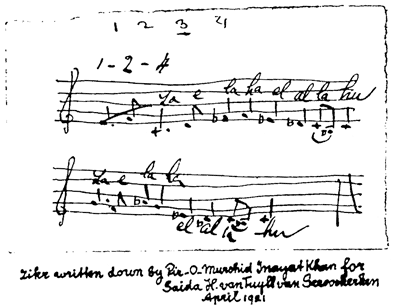|
The Singing Zikr of Pir-o-Murshid Inayat Khan was documented in a rather customary (and perhaps incorrect) westernized scale by his brother Mahboob as:
To illustrate the westernized melody as shown above, the following link is a brief instrumental excerpt from the CD called Zikar - the Singing Zikar of Hazrat Inayat Khan, composed by Pir Hidayat Inayat Khan: Zikar - the Singing Zikar of Hazrat Inayat Khan - track 2 For more information about the meaning of the words of this sacred phrase, see Attunement to the sacred phrase lā ilāha illā allāh For proper pronunciation of the phrase, it may be useful to note that the "e" and "el" indicated in the written transliteration are not pronounced at all like the sound of the "e" in the Spanish word "el", but rather (depending upon the regional dialect of the speaker) typically are spoken more like the "ee" in "feet" or perhaps the "i" in "it". For some further clues regarding the use, and misuse, of the transliteration "el", please see: The Zikr Phrase, as used by Hazrat Inayat Khan For some guidance on pronunciation, here is a composite recording of seven different native speakers chanting, reciting or singing the sacred phrase lā ilāha illā allāh: Audio recordings of lā ilāha illā allāh And, as the ultimate reference for the manner in which Pir-o-Murshid actually pronounced the phrase, here is a portion of a rare recording of Pir-O-Murshid Inayat Khan singing the phrase lā ilāha illā allāh: Pir-o-Murshid
Inayat Khan singing allāhu akbar lā ilāha illā allāh A variation on the theme? The earliest known written notation of the entire Singing Zikr was handwritten in April, 1921 by Pir-o-Murshid Inayat Khan for one of his students, Saida van Tuyll. (The additional text beneath Pir-o-Murshid's notation of the music was written by Saida van Tuyll.)
Interestingly, in this rendering of the song there is no flat on the second note (the note with the "e" above it). There are two schools of thought on this issue: On one hand, the missing flat could simply be an oversight, or, on the other hand, perhaps the flat on the second note was deliberately omitted. Each of these explanations has its own proponents. If the omission was accidental, then we simply have the same music as described above by Mahboob. Or, if the omission was deliberate, then the resulting scale, while odd by Western standards, is well known in India as Rag Bhairavi, and is the only Raga form intended to be sung at any time of the day or night. It seems most likely that the Zikr was originally introduced in the style as shown above in Inayat Khan's own handwriting, but the Indian scheme of having a natural 2nd in the ascending scale and a flat 2nd in the descending scale was too difficult for his Western students, so the ascending natural 2nd (D as written above) was changed to a flat 2nd (D-flat as shown in Mahboob's version), which is much easier for those accustomed to Western music. And, interestingly, both of these styles are Rag Bhairavi. As some further evidence that the natural 2nd in the ascending scale was in fact Pir-o-Murshid Inayat Khan's preferred form, here is an exercise which he gave to Rabia Martin in May 1911, shown here in his own handwriting:
Note that this is exactly the same melody as the first line of the Zikr which Pir-o-Murshid Inayat Khan gave to Saida van Tuyll some 10 years later, clearly with no flat on the second note in either of these renderings. To illustrate the difference in sound between these two different versions of Rag Bhairavi, here are two brief recordings of Pir Shabda Kahn and Murshida Leilah Be singing the two subtly different versions of the Zikr of Hazrat Inayat Khan. (Note that the pronunciation of the zikr phrase in these following two renderings follows Samuel Lewis' rather odd pronunciation, so while these recording are a great way to hear the intended melody, they may not be very good examples of proper pronunciation.):
Zikr of Hazrat
Inayat Khan sung in Rag Bhairavi (natural 2nd ascending) Here are Pir Shabda Kahn's thoughts on these two different versions:
Regardless of the exact details, through some long-forgotten chain of events, we are twice blessed to have inherited two versions of this magnificent zikr... which offers a delightful opportunity to explore the subtle difference in sound and discover through your own experience which version best suits your heart.
Wishing you love, harmony and beauty,
Note: For additional information about the musical career and other music by Hazrat Inayat Khan please see the article, as well as the footnotes and links at the bottom of the page at: hik_music_bio.htm
last updated 23-Feb-2015
|




